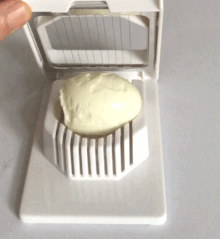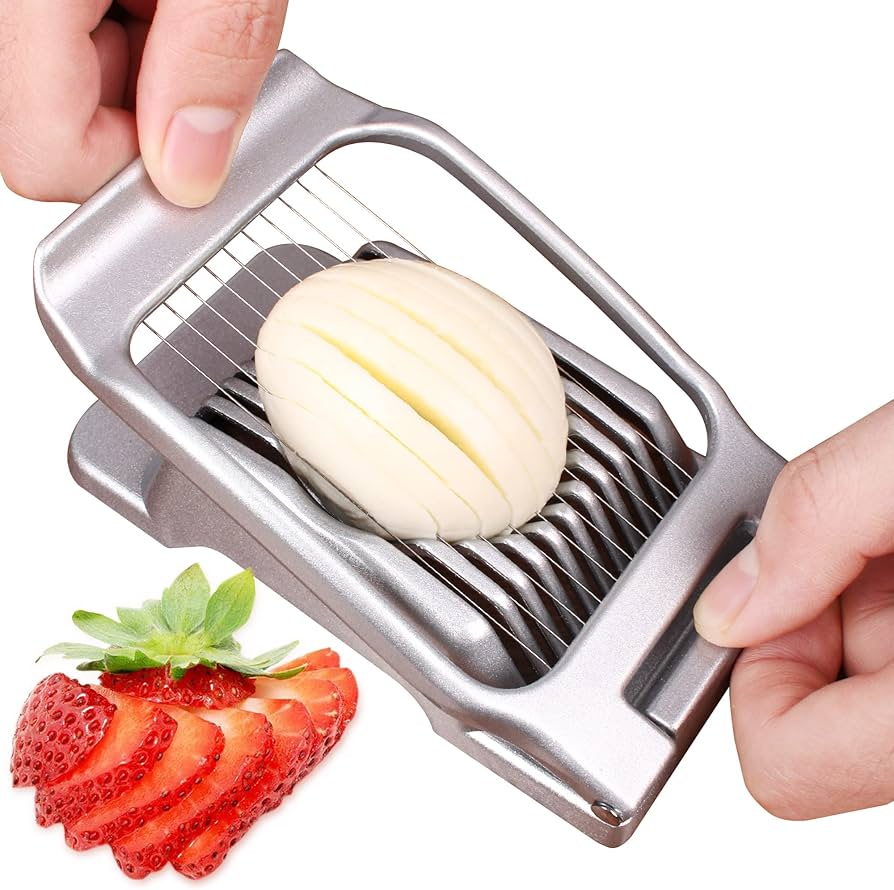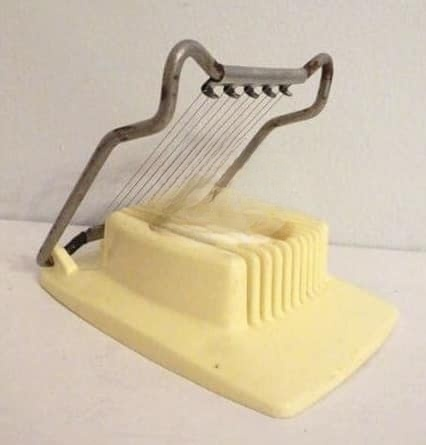When it comes to essential kitchen gadgets, the egg slicer stands out as one of those ingenious tools that has become indispensable for cooks everywhere. This seemingly simple device has revolutionized the way we prepare and present boiled eggs, transforming them into beautifully sliced components that add both elegance and convenience to our culinary creations. But have you ever wondered who invented the egg slicer and how it came to be? Let’s take a journey through the fascinating history and evolution of this essential kitchen tool.
The Origins of the Egg Slicer: A Patent Mystery

The story of the egg slicer begins with a patent filed in December 1936 by Manuel Freitas Braz from Hilo, Hawaii. Braz’s invention was designed to “provide means whereby an egg may be sliced evenly in a single operation,” according to his patent documents. This early design laid the foundation for modern egg slicers, although it didn’t quite resemble the classic look we’re familiar with today.
Intriguingly, the concept of an egg cutter dates back even earlier. In 1904, Minna Sophie Friederike Petersen filed a patent for a plier-like egg cutter, which looked similar to a garlic press. However, it wasn’t until 1912 that the classic egg slicer design was born, thanks to German inventor Willy Abel. Abel’s design featured a wire-based slicing mechanism that quickly gained popularity, selling over 10 million units worldwide. Abel didn’t stop at egg slicers; he also introduced other innovative kitchen gadgets, including a bread slicer and a heart-shaped waffle iron, cementing his place in culinary history.
The Classic Egg Slicer Design
Willy Abel’s design became the foundation for the egg slicers we know today. The classic model consists of two hinged arms: one with an array of parallel wires or blades, and the other with a flat base for holding the egg. The egg is placed on the base, and with a simple press, the wires slice through it, producing even, perfectly shaped slices.
This design is both elegant and functional, allowing for consistent results with minimal effort. It’s no wonder this tool has endured for over a century, remaining a favorite in kitchens worldwide. The simplicity of the classic egg slicer is what makes it so effective, offering a quick solution to slicing without the need for a knife.
Modern Innovations: Versatility in the Kitchen
Over time, the egg slicer has evolved to meet the diverse needs of today’s kitchen enthusiasts. Modern egg slicers now come with various features that make them more versatile, capable of slicing other soft foods beyond just eggs. Let’s explore some of these contemporary enhancements:
- Multi-Purpose Slicers: Many modern egg slicers come with interchangeable blades that allow users to slice other soft foods like strawberries, mushrooms, avocados, and even small pieces of cheese. This functionality makes the egg slicer a versatile kitchen tool, helping to speed up prep time and create uniformly sliced foods for any dish.
- Ergonomic Designs: Today’s egg slicers often feature comfortable grips and non-slip bases, which provide better control and stability while slicing. These ergonomic enhancements make the tool more accessible and easier to use, particularly for individuals with limited dexterity or hand strength.
- Integrated Storage and Safety Features: Some slicers now include built-in storage for blades and safety locks to prevent accidental injury. These features make the slicers not only functional but also safe and convenient for home cooks and professionals alike.
The Egg Slicer’s Impact on Culinary Presentation

At first glance, the egg slicer might seem like a simple gadget, but its impact on food presentation is undeniable. By creating perfectly uniform slices, the egg slicer elevates the visual appeal of dishes, transforming boiled eggs from basic ingredients into elegant garnishes. Here’s why the egg slicer has become a favorite among home cooks and professional chefs:
- Enhanced Visual Appeal: Even slices make dishes look more polished and appetizing. Egg slices are often used as decorative elements in salads, sandwiches, and appetizers, adding a touch of sophistication to the plate. The uniformity of the slices can also elevate a dish’s aesthetics, making it look professionally prepared.
- Time Efficiency: Slicing eggs with a knife can be time-consuming, especially when preparing large quantities. The egg slicer saves time by creating multiple slices with a single press, making it ideal for catering events, picnics, and family gatherings where boiled eggs are a staple.
- Versatility in Recipe Preparation: While originally designed for eggs, modern slicers allow for cutting a variety of soft foods. Whether you’re slicing avocados for a toast topping, strawberries for a fruit salad, or mushrooms for a sauté, the egg slicer’s versatility opens up new culinary possibilities.
Selecting the Right Egg Slicer: Key Considerations

With so many options on the market, choosing the right egg slicer can be a challenge. Here are some factors to consider when selecting the perfect tool for your kitchen:
- Material and Durability: Egg slicers are commonly made from plastic, aluminum, or stainless steel. Plastic models are lightweight and affordable, but they may lack long-term durability. Stainless steel slicers, while typically more expensive, offer superior strength and resistance to corrosion, making them a wise investment for those who plan to use the slicer frequently.
- Design and Functionality: Look for a slicer that fits comfortably in your hand and has a non-slip base for added stability. If you plan to use the slicer for other foods beyond eggs, consider models with interchangeable blades or compartments. This added versatility can make the slicer a go-to tool for various kitchen tasks.
- Brand Reputation and Reviews: Before making a purchase, read customer reviews to get a sense of each product’s performance and durability. Reputable brands with positive feedback are generally a safe choice, as they’ve already been tested by other home cooks and professionals.
The Egg Slicer’s Role in Kitchen History and Beyond

Since its invention over a century ago, the egg slicer has remained a beloved kitchen tool for its simplicity, functionality, and versatility. From its early beginnings as a novelty item to its status as a kitchen staple, the egg slicer has evolved to meet the changing needs of culinary enthusiasts around the world.
What started as a single-purpose tool has grown into a versatile gadget, capable of slicing a wide range of foods with precision. The egg slicer’s enduring popularity is a testament to its value in the kitchen, where it saves time, enhances presentation, and allows cooks to experiment with new recipes and techniques.
Conclusion: The Enduring Appeal of the Egg Slicer
The egg slicer may seem like a humble tool, but its impact on food preparation and presentation is undeniable. This gadget has transformed the way we approach slicing, making it quicker, easier, and more visually appealing. Whether you’re a seasoned chef or a home cook, the egg slicer offers a reliable way to elevate your dishes and experiment with new flavors and textures.
So the next time you’re preparing a salad, sandwich, or appetizer, reach for an egg slicer and enjoy the efficiency and elegance it brings to your culinary creations. The egg slicer is more than just a gadget—it’s a symbol of ingenuity, practicality, and the joy of cooking.


